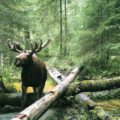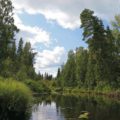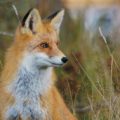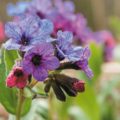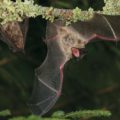The «Kologrievsky Forest Reserve» was created in order to preserve, restore and study the only primeval landscape of the Southern taiga zone in the European part of the Russian Federation.
Until the middle of the 19th century the territory of the Kostroma Zavolzhye was covered with virgin taiga. Forests in this area were different: pine, pine-spruce and fir-spruce — with an admixture of broad-leaved trees and shrubs. These were multi-species ecosystems of different ages.
In the second half of the 19th century the mastering of the primordial forests of the Kostroma Zavolzhye started, and in the second half of the 20th century intensive concentrated felling started which resulted in the destruction of the original pine forests and the establishment of the secondary soft deciduous woods in their place.
Of course, this process also affected the area where the “Kologrievsky Forest Reserve” is located at present. Before the revolution everything was stable. At the place of the Kologrievsky part of the reserve was the Shartan forestry, which was strictly protected. Significant tracts of forest were either not felled, or felled on a selective basis for about 150 years.
The territory of the Manturovsky plot was part of the state forests in Tsarist Russia. Since 1837, in accordance with the Decree on allotment of ship forests, all felling, grazing and hunting were forbidden on these lands.
But in the following years intensive exploitation of these forests began, using a predatory harvesting technique. As a result, in 1980 the workers of the Kostroma forest experimental station headed by Alexander Pismerov managed to save from clear-cutting only 918 hectares of native forest in the Kologrievsky district and to establish a federal wildlife reserve there.
The present history of the “Kologrievsky Forest Reserve” began in the 1990s, when a project for the reserve was developed under the leadership of Maxim Sinitsyn, and in 2003 it was approved by a federal ecological expertise. In 2006, thanks to the support of Vasily Peskov and leading Russian scientists, the government decree on the establishment of the reserve was signed.
In October 2020 the “Kologrievsky Forest” became a biosphere reserve — the 47th Russian protected area included by UNESCO in the list of the Specially Protected Areas of International Importance.
Territory of the Reserve
The Reserve includes two areas: Kologrievsky and Manturovsky. The first one is situated in the territory of the Kologrievsky, Neisky, Parfenevsky and Chukhlomsky districts and occupies an area of 48094.6 ha. The core of the area is the natural monument The “Kologrievskii Forest Reserve” is a small area (918 ha) of southern taiga with predominant species of spruce and fir. This area survived during clear-cutting in the 50s–80s of the 20th century. Here the forests have survived without any signs of disturbance and are therefore reference. The second site (10,845 ha) is located within the Manturovsky District. Native southern taiga pine forests with some larch trees grow at this site.
Flora and fauna
The area of the “Kologrivsky Forest Reserve” is distinguished by its specific botanic and geographical position. It is the place where the borders of European (oak, elm, alder) and Siberian (fir, larch, Siberian stone fir) vegetation meet, as well as those of taiga and broad-leaved forests. The natural-territorial complexes of the Reserve are both typical and unique. On the one hand, the natural complexes of the Reserve — coniferous forests and coniferous-broad-leaved forests, flood meadows, raised bogs and key bogs — are quite typical for southern taiga landscapes. On the other hand, typical ecosystems have become unique. The Kologrivsky Reserve is the only place in the European part of the Russian Federation where very small “islands” of indigenous southern taiga forests have survived, surrounded by an area where the same forests were felled only once and are now being restored. The process of regeneration of spruce forests is extremely interesting for scientists.
The dendrological “collection” of the “Kologrivsky Forest Reserve” is very rich — more than 40 species of trees and bushes. More than 550 vascular plant species and 111 lichen species are found in the reserve, about 70 of them are included in the Red Book of the Kostroma region and 8 — in the Red Book of the Russian Federation: real lady’s slipper orchid, leafless nadroad, baltic and Traunsteiner palchatocornerini, lobaria pulmonaria, bent-grass, Laurener nephromopsis, and Burnet leptohyum.
About 15 species of fish, 5 species of amphibians, 5 species of reptiles, 172 species of birds and 55 species of mammals inhabit the protected area. At least 10 representatives of fauna are listed in the Red Book of the Russian Federation and about 80 (including invertebrates) — in the Red Book of the Kostroma region.
Brown bear, lynx, wolf, elk, wild boar and various representatives of the wild cat family are common and numerous in the reserve. There are also rare animals such as european mink, otter, flying squirrel, several species of bats, wolverine, and red-listed birds — grey shrike, white partridge, white dove, owl, snake eagle.
Materials provided by the «Kologrievsky Forest Reserve».

